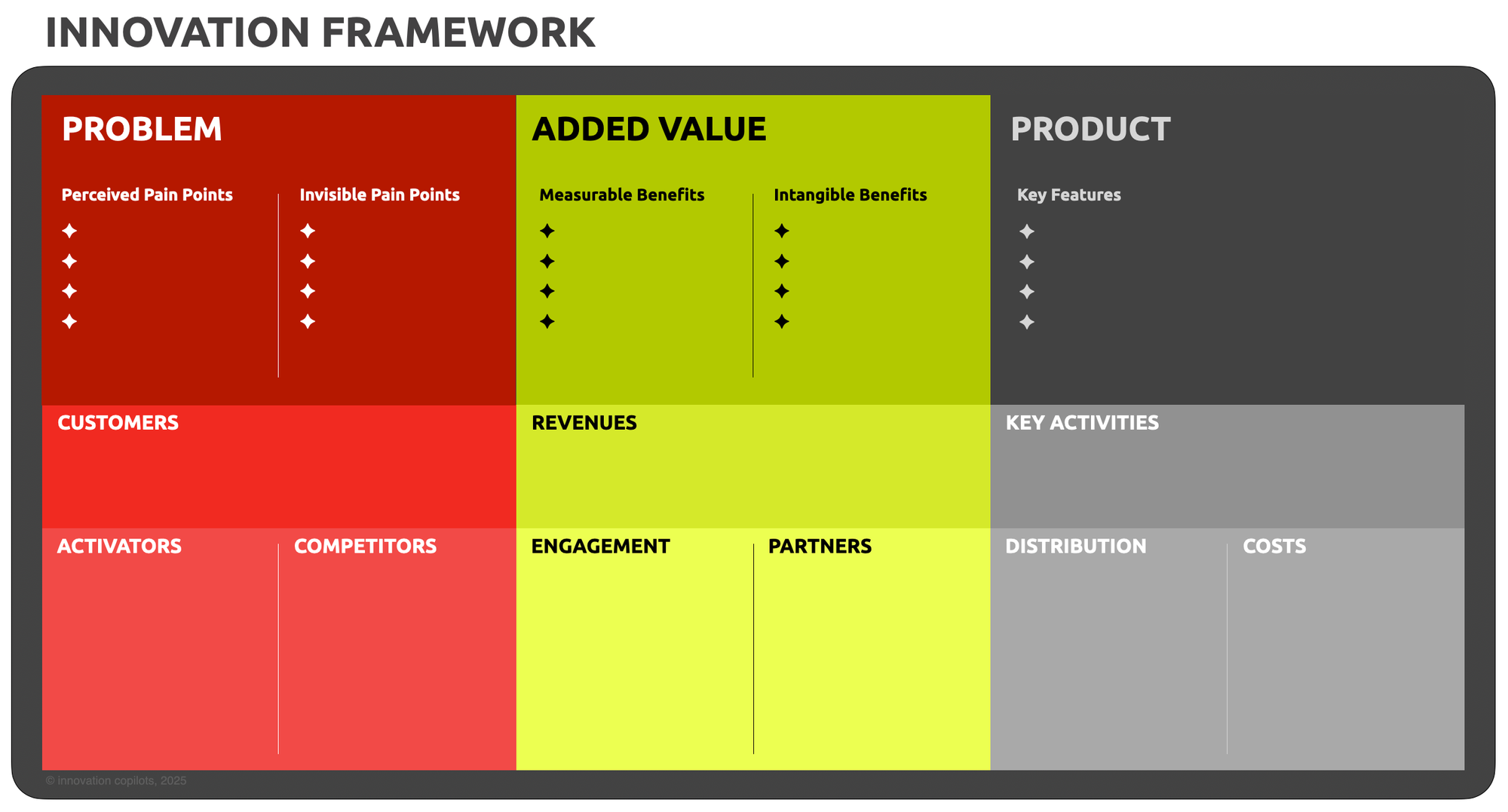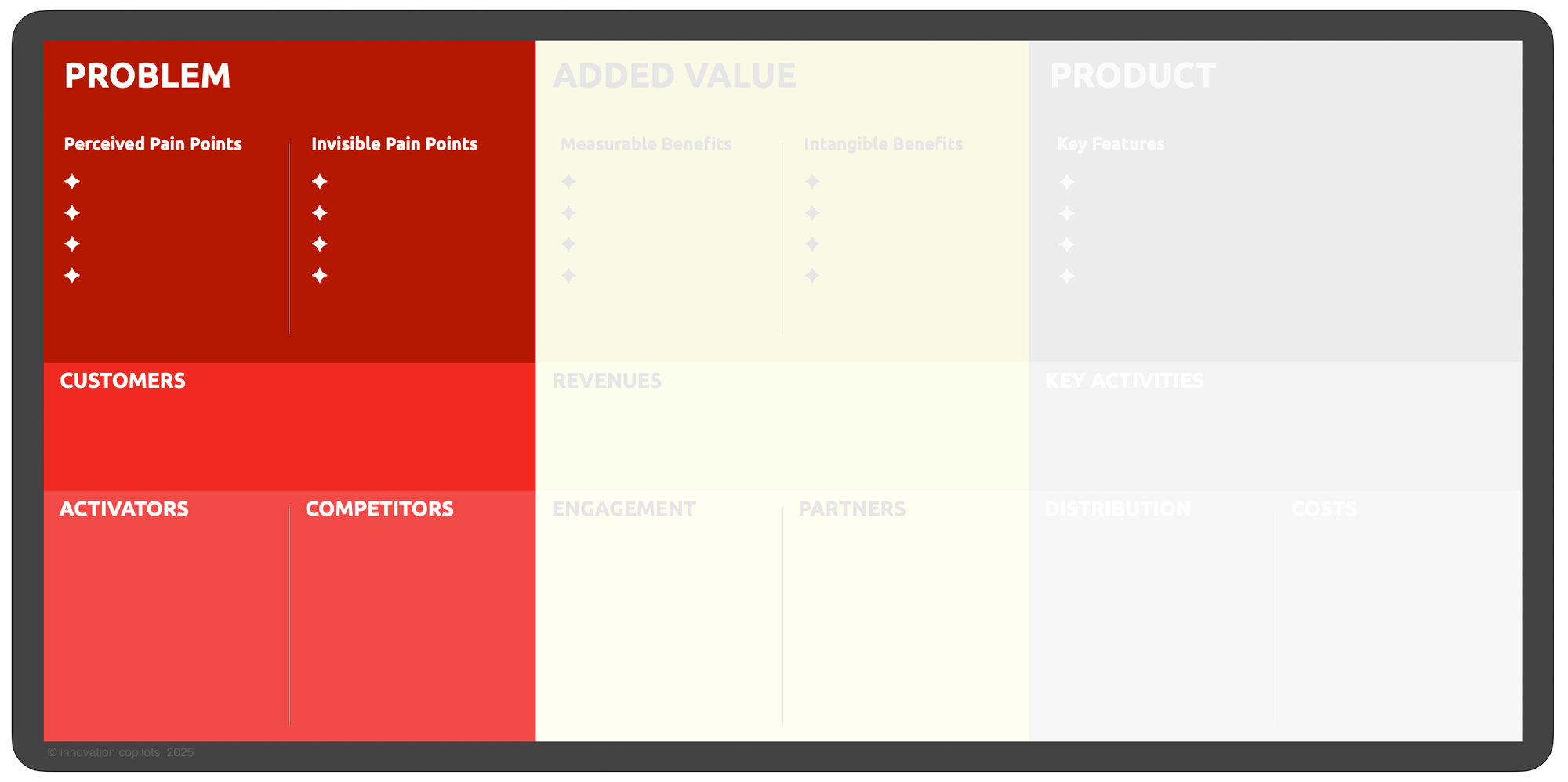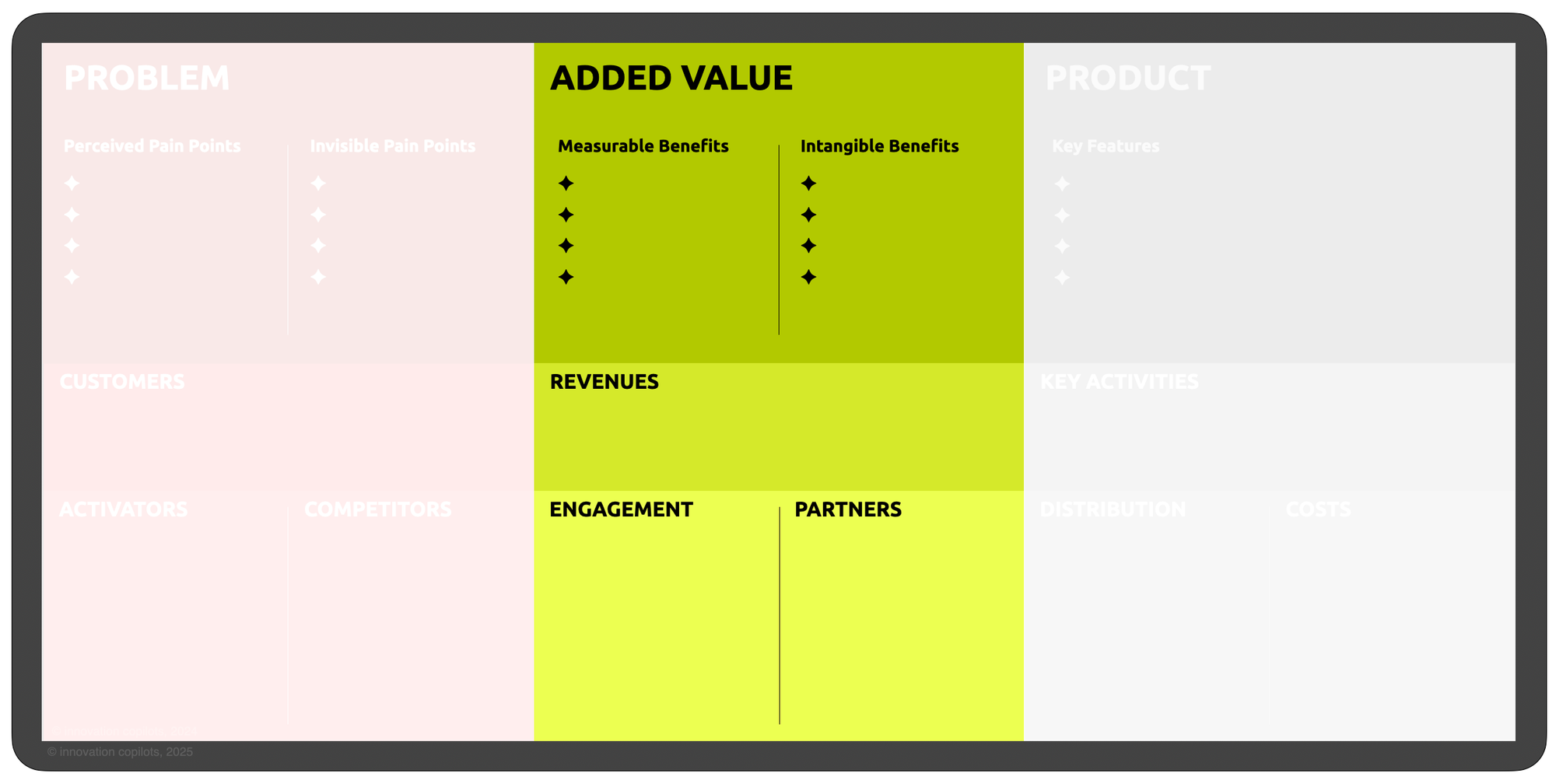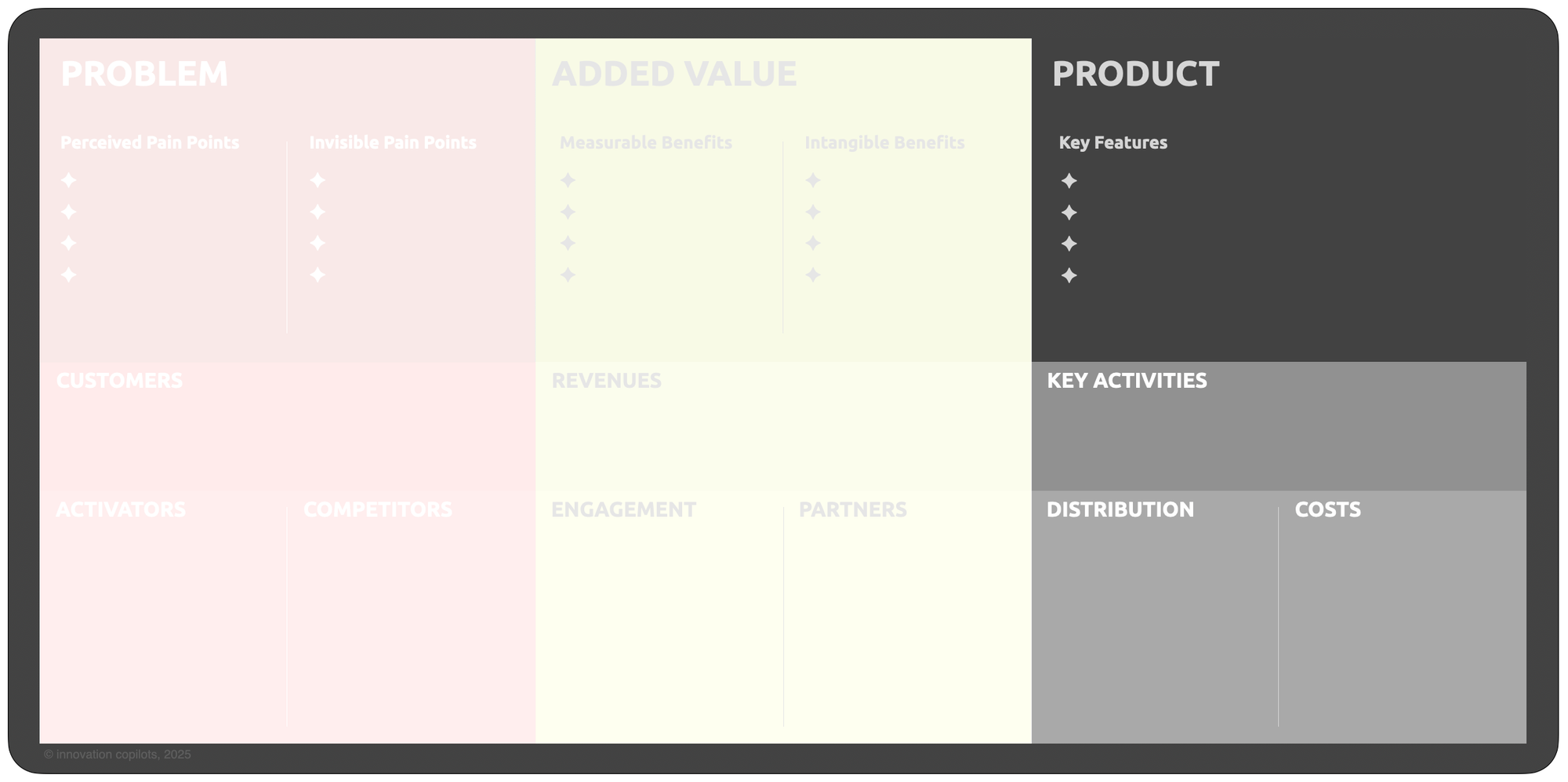🔳 Our innovation framework

This article presents our innovation framework, which we’ve been using and refining since 2009. I already made a case in 2016 for letting go of the now generic business model canvas. In short, it’s a fantastic training tool. As such, it’s very open and can be used by many trainers, consulting enthusiasts, or business schools. However, the price to pay is that it’s a blunt tool with no credo, no vision, and worse: no teeth!
Innovation is a high-velocity game that is played at a rapid pace. We require sharper tools. This is what we’ve been using for more than 10 years as our own Innovation Framework. Let’s see how it works, shall we?
The full business model of an innovation project is mapped in this framework:
Not that business model canvas
The tool we have been using and polishing for years had different names, but always the same logic. We simply call it the Innovation Framework, but this doesn’t matter much. What matters is that it lays out the most straightforward and precise logic you have to connect fast if you want to innovate anything. And this is how we deal with describing a business model for an innovation project:

Always start with the problem…

This is the core of your vision and what you are determined to change. The amount of change you will deliver will define the level of innovation you’ll deliver. Solving minor problems a step at a time provides incremental innovation. Solving problems that were previously deemed impossible is the essence of innovation. To break down the understanding of the problem, it’s usually easier to explain the key Pain points that constitute it. Some customers will perceive them, while others might still remain invisible.
Customers are simply defined by answering the question, “Who has the problem?”. A customer segment is a group of customers who share the same type and number of pain points simultaneously.
We also define the key stakeholders involved in the problem.
The Competitors are the most obvious ones: they are already solving part of the problem you focus on, or they intend to. They compete with you to remove your target customers' pain, but they might not use the same product, distribution strategy, monetization scheme, or technology.
Airbnb competes with Accor even without hotels, just as Fortnite competes with YouTubethat’s okay, but you’ll need to circle back to it as soon and Netflix to entertain you. Different products, the same problem to solve.
The other stakeholders are less discussed but are tremendously important. They are the Activators, and they are different groups of interests that talk about the ongoing problem; they can lobby for or against it, and they might be customer associations, public services, or industrial conglomerates. Because they make the problem more visible to everyone, they indirectly help you create your business.
When capital cities, such as Paris or London, study pollution and make a case for reducing car traffic on their streets, they inadvertently open the market to Uber, Lyft, Waymo, and now Lime. The market is more prone to understand the problem these companies solve. It has been 'activated.'
If the way you think your business model starts with the PROBLEM, congratulations! You are a customer-driven company (startup, project, team…). If not, that’s okay, but you’ll need to circle back to it as soon as possible. If there is no problem to solve, there is no market to innovate.
Selling your added Value!

The added value is not just your « value offer.» It describes which parts of your value proposition go beyond what your competitors are doing. In that sense, bringing « good quality,» « simple use,» or « competitive price » doesn’t explain your added value. Everyone says they bring these benefits; it’s not opposable to the market.
The Revenues of your business should be directly linked to the value you deliver to the market. Following Schumpeter’s logic: you create a value that is shared between you and the customer. What you keep is your revenue. When working on business models, it’s often referred to as ‘monetization,’ but it’s deeper than that. If you have to generate financial revenues (money), you might also generate social revenues, positive ecological externalities, etc. This should also be taken into account here.
A not-for-profit organization, for instance, would list social impact in its revenues (with its own adequate KPI). A fast-growing company such as Uber could decide to record the number of drivers on the platform as a form of revenue (it’s essentially a pre-money revenue), or Google’s Waymo could record the number of miles its self-driving prototypes are traveling monthly.
Once you visiblepotential customers is key. An oversimplification of this describes your marketing strategy, but this goes beyond it and should map all the touchpoints between you and your market.
Lastly, the partners are third parties that work with you and supply a key activity that you don’t have internally. It might be a unique distributor in a specific region, a research lab owning a patent you use, etc.
Do we forget something?

It’s never the end game, even if you have the best technology in the world ready to launch. Startups’ and corporates’ R&D programs’ graveyards are full of amazing solutions without a problem to solve!
It’s also important to note that we couldn’t care less about the product/service distinction, and we say ‘product.’ This is usually a full discussion that we should have if you’re an innovator thinking that you should design, market, or distribute products and services in critically different ways. This is not the case; it only matters for accounting and tax purposes. But this discussion would lead us into a too-deep rabbit hole for this article. Just say ‘Solution’ if you’re uncomfortable calling everything a product and be done with it.
That being said, your product will have Key Features that highlight the critical aspects of the job you’re doing for customers to solve their ProblemsAirbnb’s.
Finding several offers wherever you want to travel on the planet with Airbnb is, for instance, a key feature. It must be designed and engineered as early as possible at Airbnb’s launch to ensure the delivery of promised added value.
As important as understanding your product, you need to understand your Super-Powers. How and why you’ll get to a breakthrough product, bringwith it to the market faster than anyone else, or sustain its added value for years to come. These superpowers are your main barrier to entry to would-be competitors.
Associated with, the product, we will also explain as briefly as possible your Distribution strategy (even in SaaS, always worry that distribution could end up as the trickiest part of your business) and your cost structure (mainly, are you in Capex or Opex mode, and where are the bulk of the investments needed).
Being practical with your culture
Using this innovation framework doesn’t require starting with the problem, moving on to added value, and then deciding the product to build eventually. As I said earlier, this would be the case if you were market- or customer-driven. You can also be future-driven and envision the added value you want to create in the market, connect it later to a problem, and design your product.
In this innovation game, I must acknowledge that companies tend to start with the product by a considerable measure. Especially if they are tech or engineering companies, such as Airbus, Nissan, or Vinci, they will not culturally start to innovate by thinking about customers’ problems. But as such, being process-driven doesn’t mean you should be oblivious to the mechanics of innovation. On the contrary, starting with the product, because that’s what you do, demands that you learn how to translate features to a roadmap and added value, and assess the reality of the market needs. You need to do it as quickly as possible and with as much flexibility in your product design as possible, because, yes, you are running this race backward. No surprise here: agile and lean are key cultural issues for process-driven companies.
And if you want to know more about dealing with culture and innovation, you can also go here or there or explore our Culture Framework.
As an extra, you can find here a Mural template to use for your online workshops : )



